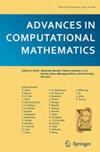不同弹性张量和不同质量密度下弹性传输特征值问题的自适应有限元模型
IF 1.7
3区 数学
Q2 MATHEMATICS, APPLIED
引用次数: 0
摘要
弹性传输特征值问题产生于反向散射理论,在弹性介质的定性重建方法中起着至关重要的作用。本文提出并分析了一种有限元法的后验误差估计器,用于求解不同弹性张量和不同质量密度的弹性透射特征值问题(\mathbb {R}^{d}~(d=2,3)\ )。设计了一种基于后验误差估计的自适应算法。数值结果说明了自适应算法的效率。本文章由计算机程序翻译,如有差异,请以英文原文为准。
An adaptive FEM for the elastic transmission eigenvalue problem with different elastic tensors and different mass densities
The elastic transmission eigenvalue problem, arising from the inverse scattering theory, plays a critical role in the qualitative reconstruction methods for elastic media. This paper proposes and analyzes an a posteriori error estimator of the finite element method for solving the elastic transmission eigenvalue problem with different elastic tensors and different mass densities in \(\mathbb {R}^{d}~(d=2,3)\). An adaptive algorithm based on the a posteriori error estimators is designed. Numerical results are provided to illustrate the efficiency of our adaptive algorithm.
求助全文
通过发布文献求助,成功后即可免费获取论文全文。
去求助
来源期刊
CiteScore
3.00
自引率
5.90%
发文量
68
审稿时长
3 months
期刊介绍:
Advances in Computational Mathematics publishes high quality, accessible and original articles at the forefront of computational and applied mathematics, with a clear potential for impact across the sciences. The journal emphasizes three core areas: approximation theory and computational geometry; numerical analysis, modelling and simulation; imaging, signal processing and data analysis.
This journal welcomes papers that are accessible to a broad audience in the mathematical sciences and that show either an advance in computational methodology or a novel scientific application area, or both. Methods papers should rely on rigorous analysis and/or convincing numerical studies.

 求助内容:
求助内容: 应助结果提醒方式:
应助结果提醒方式:


